How law enforcement officers mutilated protesters, a study by Mediazona
13 October 2020, 14:30 | Maxim Litavrin, David Frenkel, Egor Skovoroda, Anastasia Boyko, Mediazona
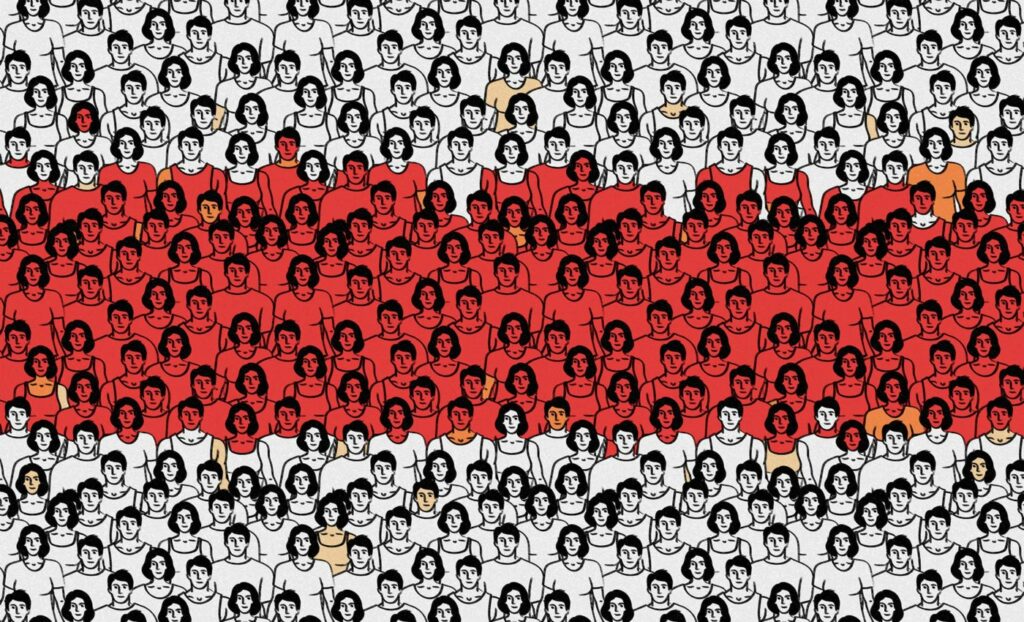
Amidst the protests that swept the country in August-September 2020, at least 1,376 people in Minsk were affected by the brutal actions of the arresting officers. Every third was moderately injured or mutilated. More than 600 people were beaten up not while attending the rallies, but once they’d been detained, at the police stations and Akrestina detention center. At least three incidents of sexual violence, one of the raped being a minor, have been reported. Mediazona has thoroughly examined the documents provided by a source in the Investigative Committee.
Government agencies have never published any official statistics on the injured protesters; nevertheless, the security forces have been collecting the data. An anonymous source contacted the Mediazona office to hand over some Investigative Committee files on the injured protesters in Minsk. The files contain several tables with brief information on each case, as well as alleged torture investigation reports. The Mediazona team have meticulously processed and analyzed the data to obtain descriptive statistics.
Why the anonymous source is to be trusted
One of the files received by Mediazona was identical to the one submitted earlier by another anonymous source. This is a list of injuries caused by stun grenades, rubber bullets and tear gas.
Some of the records mentioned the medical facilities the victims were taken to. Our sources at City Clinical Hospital No.10 (CCH No.10) reported they had no records on just two people from the list, meanwhile Emergency Medical Care Hospital (EMCH) confirmed the match of the entire ER patients list. Multiple severe cases associated with eye injuries, traumatic amputations, coma and death were earlier covered by Mediazona and other journalists. The medical case reports tallied up with the data in the files.
The information on the detainees beaten up and injured at the Akrestsina detention center was compared against the lists of names compiled by human rights defenders of the Viasna center.
In addition, the authenticity of the files and tables was confirmed by a Mediazona source in one of the Investigative Committee central departments.
Injury assessment method
The Investigative Committee materials listed the medical conditions the protesters were diagnosed with. The injuries of each 1,376 victims were body-mapped to clearly determine the most severely affected body parts.
Each injury is classified according to the following severity scoring scale: minor (1), moderate (2), and severe (3). 0 points are assigned to a body part spared from any kinds of damage. The injuries were also grouped according to injury sources: beatings, rubber bullets, stun grenades, or tear gas.
Bruises, haematomas and minor burns are scored as minor injuries (1); lacerations, TBIs (traumatic brain injuries) and multiple trauma as moderate (2), and penetrating gunshot wounds, damaged internal organs, fractures and traumatic amputations as severe (3).
The police direct-fired at vital organs
Young men were affected the most at the rallies. The average age of the injured is 31 years. The most serious injuries were inflicted by non-lethal weapons, i.e. rubber bullets and stun grenades.
Protesters Injury Map
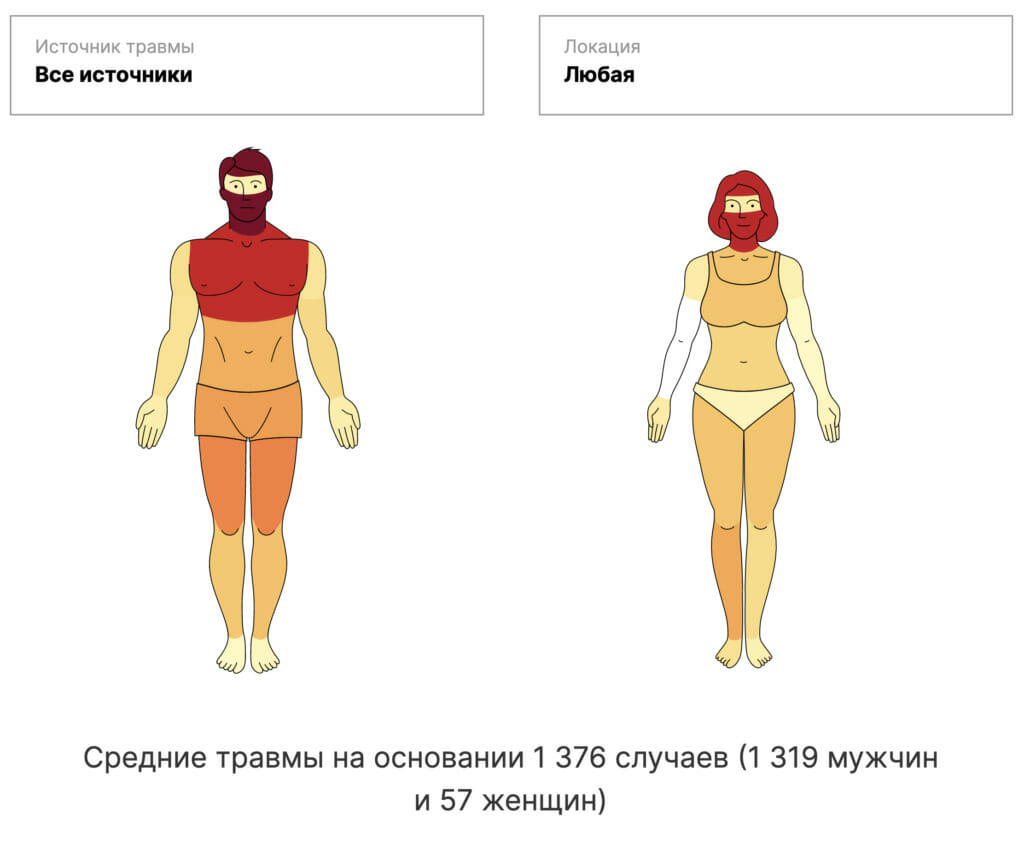
Injury cause: Any
Injury location: Any
Source: Mediazona
The injuries inflicted by rubber bullets (40 cases) show that during the protest suppression, the security forces aimed at the head, chest and stomach; such shots caused the most crippling injuries. It was a chest gunshot that on 10 August killed 34-year-old Aliaksandr Taraikouski, who was walking towards the riot police chain with his arms up near the Pushkinskaya metro station.
Another rally participant, a 37-year-old man, fell into a three-day coma after having been shot in the chest with the bullet damaging his right lung. The man was later diagnosed with an open pneumothorax. An abdominal gunshot wound resulted in a small intestine hernia in a 24-year-old protester.
Where did the Investigative Committee get the data on the victims and how many people were injured?
The total number of victims injured at the rallies is hard to determine. The received data only relate to the detainees in Minsk and Zhodino detention centers; however, violence was used in other cities as well. Besides, the Investigative Committee is only aware of the cases when a protester was admitted to a hospital, or filed a claim against the law enforcement officers.
Mediazona‘s source in CCH No.10, the healthcare facility where the wounded at the rallies were taken to, explains that these types of injuries are mandatory to be reported to the authorities. The obligatory reporting procedure is also confirmed by a paramedic of one of the MInsk ambulance stations, “In case a patient is diagnosed with a closed TBI, joint dislocations, fractures, etc., all our ambulance call reports are to include an alleged injury cause. We reported a ‘criminal act of violence’ with a note that, according to the patient, [the injuries] were inflicted by police officers, riot or traffic police.” All such reports shall be submitted to the police authorities. A designated person, or physician or surgeon participating in the filing of a report are later to make a statement.
Many protesters who might have been injured, either did not require medical care, or chose to turn to medical volunteers and not to file a claim to the Investigative Committee. In fact, filing a claim against arresting officers might backfire on the victims themselves – there are cases when criminal charges were pressed against the injured, but not against the police officers. As a result, the victims of police brutality are forced to hide, flee the country and stay away from police authorities.
When fired at head, rubber bullets caused closed TBIs and facial fractures. Thus, a 40-year-old protester was hospitalized and diagnosed with a closed traumatic brain injury, concussion, multiple gunshot wounds of the right lower jaw. The man also received chest, abdomen and left thigh injuries. A rubber bullet, shot at a 29-year-old protester, smashed the maxillary sinus fracturing the nose and resulting in bone fragment displacement. Another victim was shot in the eye and suffered a severe concussion.
Protesters mutilated with stun grenades
Stun grenades were massively used in the early days of the protests. When detonated thigh-high in the crowd, stun grenade shrapnel inflicted laceration wounds anywhere on the body, with the blastwave causing concussions and TBIs. Stun grenade explosions produced the injuries just as severe as those of rubber bullets.
One of the victims, a 30-year-old man, had his right foot blown off. Two other protesters sustained a comminuted fracture of left fingers, comminuted fractures of the left foot and calf bone with fragment displacement. A 33-year-old man was diagnosed with a lumbar vertebrae fracture. A stun grenade fragment hit another victim right into the chest, which led to pneumothorax.
Due to the severity of wounds, most of the victims of non-lethal weapons were hospital-admitted immediately from the streets, not from police stations or detention facilities.
The most severely affected patients were taken to receive medical treatment to the military hospital; the others with less serious injuries were admitted to the city clinical or emergency medical care hospitals of the town.
“Most of the treated injuries were multiple traumas, with closed TBIs being the most common. The patients with brain injuries would often have accompanying rib or lower \ upper limb bone fractures of various severity. We no longer assessed haematomas, bruises or abrasions, just noted down their location,” one of the ambulance paramedics told Mediazona.
Most beaten after detention, not amidst street clashes
More than a half of the victims were injured in prisoner transport vehicles (PTV), police stations and Akrestsina and Zhodino Detention centers, so they were not resisting the officers or posing any threat. Many were beaten repeatedly and systematically – at the moment of the arrest, in police vans or at police stations and later at the detention centers. In some cases, the tortures and beatings continued for several days.
Detainees deliberately hit on head and buttocks
After the beatings at Akrestsina detention center and the police stations, the victims were discharged with TBIs, major haematomas on back, waist, shoulders, buttocks and thighs. Nearly 200 people were diagnosed with traumatic brain injuries and concussions. The detainees were most likely made to lay face down on the ground or facing the wall and then beaten with batons. On October 11, NEXTA Telegram channel posted a video showing the detainees at the Offender Detention Center (ODC) chased through a line of the police officers who were continuously beating them.
More than 25 people, after having been beaten at the police stations and at the Akrestsina detention center, were reaching out for medical help with fractures and severe injuries. A 21-year-old young man was so violently beaten that it led to a left primary bronchus rupture and pneumomediastinum (air escaping from lungs \ airways into the chest cavity). His peer had two broken ribs; his entire body was literally beaten blue, with bruises and haematomas on his chest, back, hips, knees, shoulders and left arm.
Sexual violence traumas reported
The injuries sustained by three detainees at the Akrestsin detention center and in a police vehicle are clearly indicative of the sexual assault. A 31-year-old man was hospital-admitted with intamucosal hemorrhage in rectal ampulla; a 29-year-old man with anal fissure and bleeding. The third victim is a 17-year-old teenager diagnosed, among other injuries, with a rectal mucosal lesion.
10 August violence outbreak: protesters beaten at police stations and detention centers
The most severe dispersal of the protesters by the riot police occured on 10 August. As a result, at least 291 people were injured in the streets, apart from the beatings at the police stations and Akrestsina detention center.
The very same day saw the most massive arrests with more than 3 thousand people taken to police stations. After 10 August, the police basically were beating those who had already been detained or were under arrest – these spots at Akrestsina detention center and police stations are marked on the Minsk map below.
The fierce clashes with the law enforcement continued 13 September during the march to Drazdy, top-state officials’ residence. For the first time that month, more than two dozen cases of violence were registered. No data is available after 13 September.
Minsk Haematomas Map
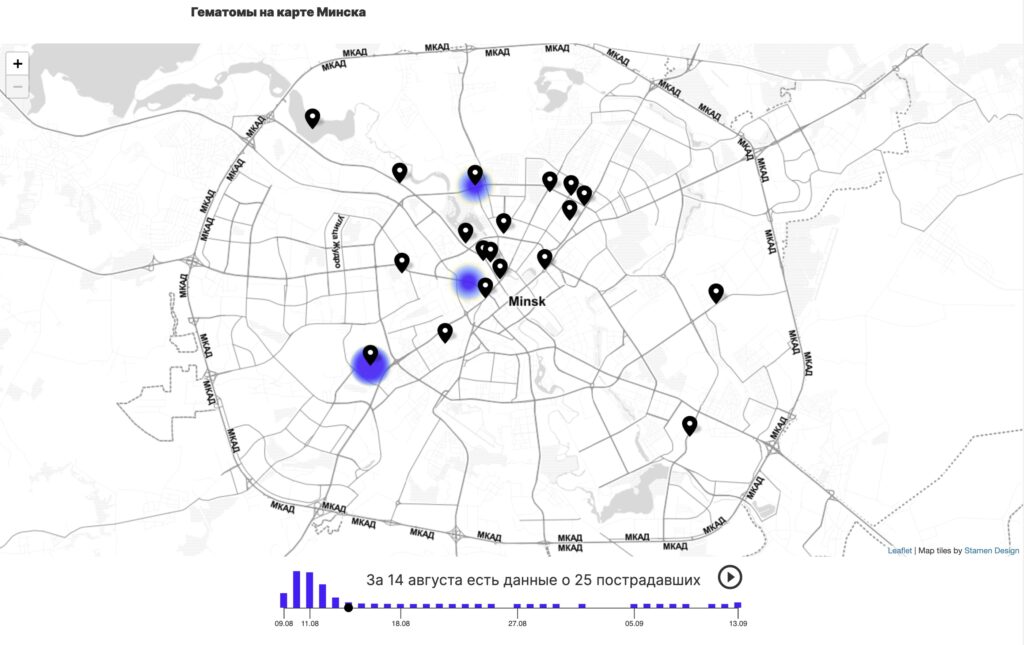
[August / September] [number of victims]
Source: Mediazona
Women and teenagers not spared: everyone falls victim to police brutality
The police violence was massive and no one got spared – the arresting officers were not trying to suppress certain groups they considered a threat, but were beating literally everyone around. The number of drunk people among the victims is insignificant – less than 2%, which contradicts all propaganda reports. Not a single case of drug intoxication is reported.
24 victims are minors who were beaten just as severely to cause concussions, bruises and massive haematomas. 17-year-old Timur M. had to be drug-induced into a coma to survive the beatings.
57 victims are female, with the oldest being a 72-year-old. On 12 August, she was beaten by the police officers in front of the pre-trial detention center on Volodarsky Street; the woman sustained a wrist fracture. Women were also tortured after having been arrested. The injury severity clearly suggests the gender was not the reason to be spared from police savagery. At the same time, women were not detained less often. After the first days of protests when women walked out less massively, women’s marches and chains of solidarity were organized countrywide the mass arrests started.
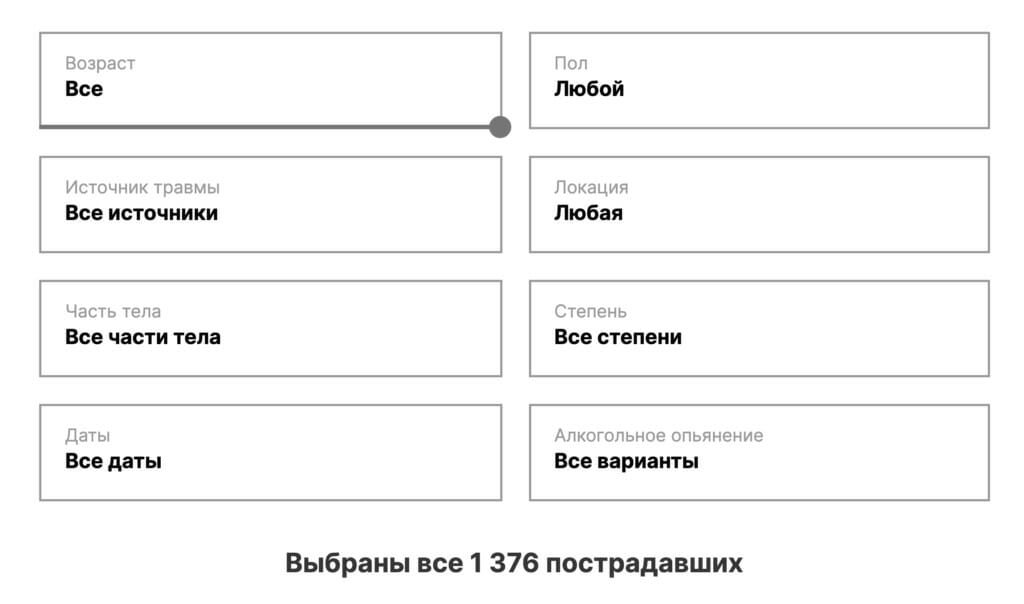
Age: All, Under X
Gender: Any, Men, Women
Injury source: Any, Beating, Gunshot, Tear gas, Stun grenade
Injury inflicted at: Any, Street, Akrestina, police station
Body part: Any, Head, Body, Legs, Arms, Unknown
Severity: Any, Minor, Moderate, Severe
Dates: All dates, Election Day 9 August, 10 August Rally, 11 August Rally, 12 August Rally, 13 September Rally at Drazdy (top-state officials’ residence)
Alcohol Intoxication: Any, Yes, No
All 1,376 victims selected
Shown [number] out of 1,376 victims
Source: Mediazona
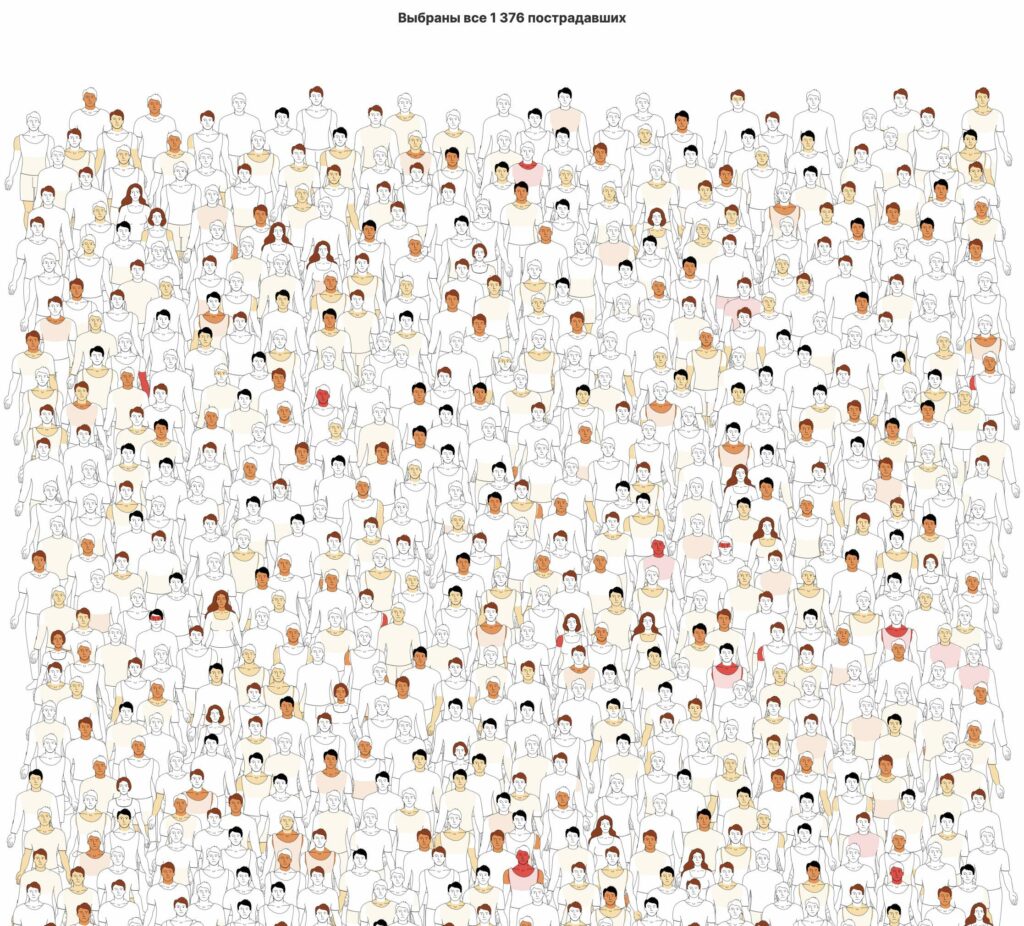
Source: Mediazona
Not a single criminal case is known to have been initiated to investigate police brutality at the rallies. The Minsk Prosecutor’s Office refused to provide any comments on torture investigations at the Akrestina detention center citing ‘sensitive information’ as the reason.
On 11 October, the law enforcement again resorted to violent detentions and beatings of the protesters. The First Deputy Interior Minister said the police will use lethal weapons if need be.
Editing by Dmitry Treshchanin
Written by Maxim Litavrin, Anastasia Boyko
Infographics by David Frenkel, Nikita Shulaev
Drawing by Maria Tolstova
Data analysis by Egor Skovoroda, Maxim Litavrin, Anastasia Boyko, David Frenkel, Dmitry Treshchanin, Anastasia Poriseva, Khatima Mutaeva, Victoria Rozhitsyna, Mikhail Lebedev